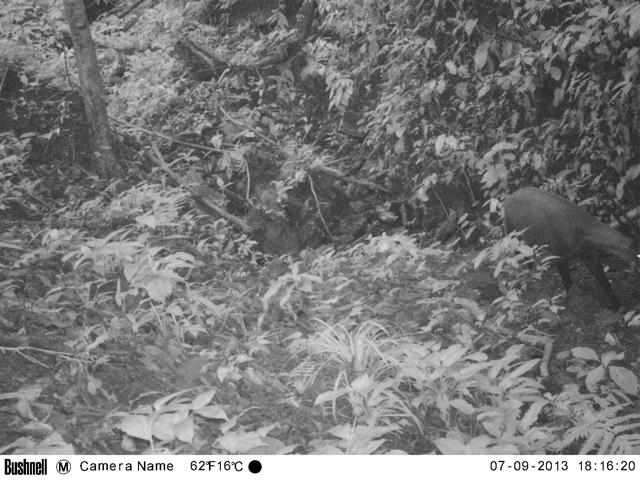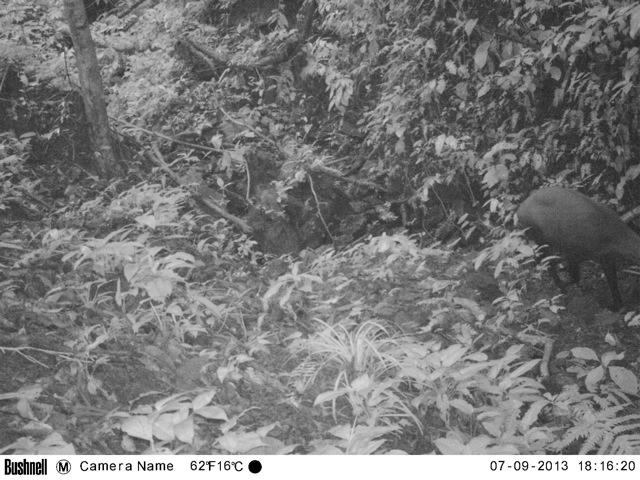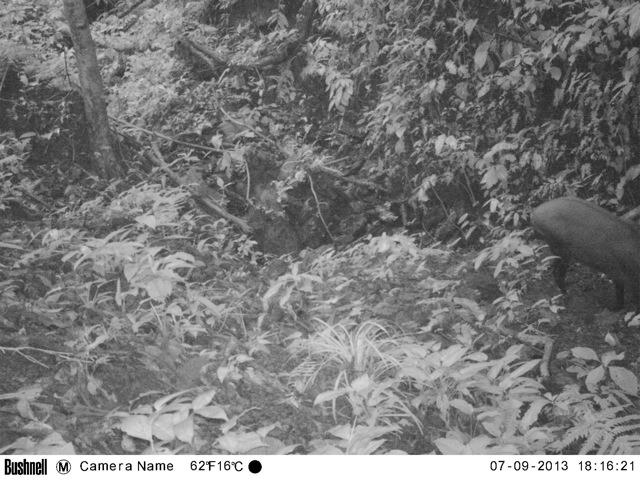Rediscovery of Saola
Posted by: Craig Woolheater on November 15th, 2013
From press release:
Date November 12, 2013
Hanoi, Vietnam – The saola, one of the rarest and most threatened mammals on the planet, has been photographed in Vietnam for the first time in the 21st century. The enigmatic species was caught on film in September by a camera trap set by World Wildlife Fund (WWF) and the Vietnamese government’s Forest Protection Department in the Central Annamite mountains.

Camera trap photo taken on 7 September 2013 at early evening shows a single saola moving along a rocky forest valley stream in a remote corner of the Central Annamite mountains of Vietnam. Credit: © WWF-Vietnam.
“When our team first looked at the photos we couldn’t believe our eyes. Saola are the holy grail for South-east Asian conservationists so there was a lot of excitement,” said Dr. Van Ngoc Thinh, WWF-Vietnam’s Country Director. “This is a breath-taking discovery and renews hope for the recovery of the species.”

Camera trap photo taken on 7 September 2013 at early evening shows a single saola moving along a rocky forest valley stream in a remote corner of the Central Annamite mountains of Vietnam. Credit: © WWF-Vietnam.
A cousin of cattle but recalling an antelope in appearance, the critically endangered saola, dubbed the Asian unicorn because it is so rarely seen, is recognized by two parallel horns with sharp ends which can reach 50 inches in length.
“This is a monumental find and comes at a critical moment in time for saola conservation,” said Dr. Barney Long, Director, Species Conservation Program, WWF. “It’s a huge reward for decades of tireless work by the provincial government who established the saola reserve, community snare removal teams and WWF biologists. Now it’s time to double our efforts to recover this iconic species.”

Camera trap photo taken on 7 September 2013 at early evening shows a single saola moving along a rocky forest valley stream in a remote corner of the Central Annamite mountains of Vietnam. Credit: © WWF-Vietnam.
The last confirmed record of a saola in the wild was in 1999 from camera-trap photos taken in the Laos province of Bolikhamxay. In 2010, villagers in Bolikhamxay captured a saola. The animal subsequently died.
“In Vietnam, the last sighting of a saola in the wild was in 1998,” said Dang Dinh Nguyen, Deputy Head of Quang Nam Forest Protection Department and Director of Quang Nam’s Saola Nature Reserve. “This is an historic moment in Vietnam’s efforts to protect our extraordinary biodiversity, and provides powerful evidence of the effectiveness of conservation efforts in critical saola habitat.”
In the area where the saola was photographed, WWF’s Preservation of Carbon Sinks and Biodiversity Conservation (CarBi) Program has implemented an innovative law enforcement model in which Forest Guards are recruited from local communities, and co-managed by WWF and Vietnamese government counterparts, to remove snares and tackle illegal hunting, the greatest threat to the saola’s survival.
“Saola are caught in wire snares set by hunters to catch other animals, such as deer and civets, which are largely destined for the lucrative illegal wildlife trade,” said Dr. Van Ngoc. “Since 2011, forest guard patrols in the CarBi area have removed more than 30,000 snares from this critical saola habitat and destroyed more than 600 illegal hunters’ camps. Confirmation of the presence of the saola in this area is a testament to the dedicated and tireless efforts of these forest guards.”
The saola was discovered in 1992 by a joint team from Vietnam’s Ministry of Agriculture and Rural Development and WWF surveying the forests of Vu Quang, near Vietnam’s border with Laos. The team found a skull with unusual horns in a hunter’s home. Proven to be the first large mammal new to science in more than 50 years, the find was one of the most spectacular species discoveries of the 20th century.
Twenty years on, the animal’s elusive nature has prevented scientists from making a precise population estimate. At best, no more than a few hundred, and maybe only a few tens, survive in the remote, dense forests along the Vietnam-Laos border.
The saola is an icon for biodiversity in the Annamite mountains that run along the border of Vietnam and Laos. The area boasts an incredible diversity of rare species, with many found nowhere else in the world. In addition to the discovery of the saola, two species of deer, the large-antlered muntjac and the Truong Son muntjac, were discovered in the Annamite’s forests in 1994 and 1997 respectively.
The saola sighting confirms the species’ persistence in Vietnam’s Central Annamite mountains and will help WWF and partners in the search for other individuals, and in targeting the essential protection needed. WWF is also providing alternative livelihood options for communities bordering the Saola Nature Reserves to help reduce poaching and provide much needed income to villagers. This work is a critical complement to law enforcement and protection efforts, and will help wildlife across the Central Annamites recover.
About Craig Woolheater
Co-founder of Cryptomundo in 2005.
I have appeared in or contributed to the following TV programs, documentaries and films:
OLN's Mysterious Encounters: "Caddo Critter", Southern Fried Bigfoot, Travel Channel's Weird Travels: "Bigfoot", History Channel's MonsterQuest: "Swamp Stalker", The Wild Man of the Navidad, Destination America's Monsters and Mysteries in America: Texas Terror - Lake Worth Monster, Animal Planet's Finding Bigfoot: Return to Boggy Creek and Beast of the Bayou.









A great find. Proves that camera traps can and do work. Nice to see things surviving but, lets drop the unicorn connection. This animal is in the bovine family…not even close to a unicorn, but a very small type of cattle. I’m aware that the unicorn moniker derives from being rarely seen. Just thought I’d nip that response item in the bud.
That is so good
More people see sasquatch and yeti. Just saying.
Seriously, those who think there is no connection between the search for – and subsequent “disappearance” of – this animal and the search – such as it is – for those two cryptids simply hasn’t thought much about this.
But haven’t we seen that before.
cryptokellie: “Not even close to a unicorn”? You make it sound as if there were an established taxonomy for unicorns. I’m pretty sure that’s not the case.
But what’s with the black and white photos? The WWF cannot afford color trailcams? I’m pretty sure Cabela’s could have cut them a good deal! Black and white photos are quite lacking in the contrast department.